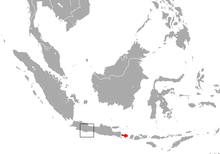Canut's horseshoe bat
Canut's horseshoe bat (Rhinolophus canuti) is a species of bat in the family Rhinolophidae. It is endemic to Indonesia.
| Canut's horseshoe bat | |
|---|---|
 | |
| Scientific classification | |
| Kingdom: | Animalia |
| Phylum: | Chordata |
| Class: | Mammalia |
| Order: | Chiroptera |
| Family: | Rhinolophidae |
| Genus: | Rhinolophus |
| Species: | R. canuti |
| Binomial name | |
| Rhinolophus canuti | |
 | |
| Canut's horseshoe bat range | |
Taxonomy and etymology
It was described as a new species in 1909 by Oldfield Thomas and Robert Charles Wroughton.[2] They chose the species name "canuti" to honor Danish mammalogist Knud Andersen. "Canute" is an anglicization of the Danish name "Knud."[3] Thomas and Wroughton chose to honor Andersen when naming the species "in recognition of the exhaustive work he has done on this complicated and difficult group."[2]
Description
Its skull has a rostral projection; the projection is on the top of the skull, with its leading edge aligned over the fourth premolar. Its head and body is 65 mm (2.6 in) long. Its tail is 22 mm (0.87 in); its ears are 24 mm (0.94 in). It has a very narrow connecting process between the sella and the posterior lancet.[2]
Biology
It is insectivorous. It is nocturnal, roosting in sheltered places during the day such as caves.[4] These roosts likely consist of many individuals, as it is presumed to be a colonial species.[1]
Conservation
It is currently evaluated as vulnerable by the IUCN. It meets the criteria for this assessment because its extent of occurrence is less than 20,000 km2 (7,700 sq mi); its ranges is fragmented; it depends on forests; and it is losing habitat. It is thought that its population size is decreasing.[1]
References
- Hutson, A.M.; Kingston, T. & Csorba, G. (2008). "Rhinolophus canuti". The IUCN Red List of Threatened Species. IUCN. 2008: e.T19528A8954148. doi:10.2305/IUCN.UK.2008.RLTS.T19528A8954148.en.
- Thomas, O.; Wroughton, R. C. (1909). "On a Collection of Mammals from Western Java presented to the National Museum by Mr. W. E. Balston". Proceedings of the Zoological Society of London. 1909: 378–379.
- Sheard, K. M. (2011). Llewellyn's Complete Book of Names for Pagans, Wiccans, Witches, Druids, Heathens, Mages, Shamans & Independent Thinkers of All Sorts who are Curious about Names from Every Place and Every Time. 4. Llewellyn Worldwide. p. 120. ISBN 9780738723686.
- Ikranagara, R. D. F.; Hasanah, U.; Aryani, R. D.; Jatiningsih, H. (2014). "Map distribution of Rhinolophus canuti (Canut's Horseshoe Bat) in Gunung Sewu Karst Area, Yogakarta" (PDF). Asian Journal of Conservation Biology. 3 (2): 149–151.
